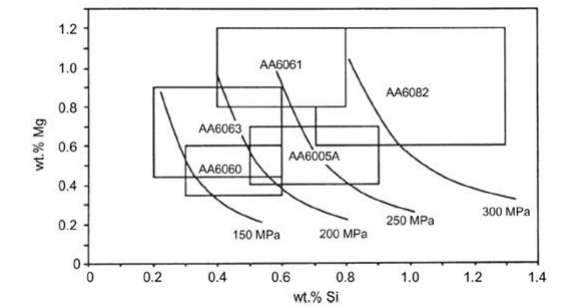This article explores the realm of the Youngman Aluminium Scaffold Strength-to-Weight Ratio, looking at the benefits of choosing Aluminium 6082T6 versus Aluminium 6063T6. We investigate how the specified thickness, testing facilities, welding certificates, and compliance with load capacity criteria contribute to the robustness and safety of these scaffolds.
Aluminium GRADE:
6082T6 marine grade and 1.63mm +/- 0.2mm
Strength-to-Weight Ratio:
a. Material: Aluminium 6082T6
Strength-to-Weight Ratio: Around 255 MPA
Thickness: 1.63mm
Additional Information: Aluminium 6082T6 is a type of aluminium that is stronger in relation to its weight compared to aluminium 6063T6. It is often chosen for scaffolding because it offers a good balance of strength and weight. The specified thickness of 1.63mm helps maintain the desired strength while keeping the overall weight of the scaffold lower.
b. Material: Aluminium 6063T6
Strength-to-Weight Ratio: Around 190 MPA
Thickness: 2.2mm or higher
Additional Information: In order for aluminium 6063T6 to achieve the same level of strength as aluminium 6082T6, it needs to be thicker, at least 2.2mm or even thicker. However, this increased thickness adds more weight to the scaffold construction.
By comparing the strength-to-weight ratios of the two materials and specifying their respective thicknesses, we can see that aluminium 6082T6 has an advantage due to its higher strength-to-weight ratio and its ability to maintain desired strength with a thinner thickness, resulting in lighter scaffold construction.
6082T6 Marine Grade
Basically, Scaffolding is a structural grade and in structure, yield strength is very important, Yield Strength of 6082 T6 is 255MPA, in all other grades cannot achieve this.

Illustration of the composition limits of some 6xxx alloys, and contours of T6 yield strength.

How we can achieve this?
1) Testing Facilities - The aluminium extrusion used in the scaffold undergoes testing to ensure it meets the required standards. The chemical composition of the material is tested according to EN 573-3, and its mechanical properties are assessed following EN 755 guidelines. Tolerances and allowances are also checked as per EN 755-8&9. All material test certificates are obtained from a TUV lab, which is a trusted testing facility.
2) Stiffness Test - The complete tower structure of the aluminium scaffold undergoes a stiffness test according to the latest annexure of EN 1004:2022. This test checks the scaffold's stiffness to ensure it meets the requirements specified in the standard. The test is conducted under the observation of a third party, providing independent verification of compliance.
3) Harness Test - To check the hardness of aluminium alloy 6082T6, a Webster gauge can be used. This portable tool measures how resistant the material is to being dented or deformed. Higher gauge readings mean the aluminum is harder. Testing the hardness helps ensure that aluminium alloy 6082T6 meets the required standards for its intended use. The reading in the gauge shall be 16
2. Welding Certifications:
- Minimal heat-affected zones: The use of CMT (Cold Metal Transfer Technology) in welding helps minimize heat-affected zones in aluminium scaffold joints. This is crucial as it prevents distortion or weakening of the aluminium structure, resulting in stronger and more durable connections.
- Compliance with industry standards: Adhering to standards such as BS EN ISO 15614-2 and BS EN ISO 15613 ensures that the welding procedures meet recognized industry benchmarks for aluminium scaffold construction. Compliance with these standards guarantees the structural integrity and safety of the scaffold.
- The expertise of skilled welders: Comprehensive assessments and qualifications according to BS EN ISO 9606-2:2004 and BS EN ISO 10042:2005 ensure that the welders possess the necessary skills and knowledge specific to aluminium scaffold welding. Their expertise plays a vital role in achieving accurate and reliable welds.
- Guidelines for consistent quality: Following the guidelines outlined in BS EN ISO 1011-1 to 4:2000 ensures consistent quality in aluminium scaffold weld applications. These guidelines cover essential aspects such as joint preparation, filler material selection, and welding techniques, enabling reliable and standardized results.
- Thorough non-destructive testing: Non-destructive testing (NDT) inspections, including visual and dye penetrant examinations, provide an additional layer of quality assurance. These inspections detect any defects or discontinuities in the welds, ensuring the integrity and safety of the aluminium scaffold.
3. Insufficient Load Capacity:
Ignoring the load capacity requirements outlined in EN 1004 can lead to a scaffold that is unable to support the intended weight or load. This could result in structural failure, collapse, and potential injuries to workers or damage to property. Adhering to load capacity standards ensures that the scaffold is designed and built to handle the expected loads safely.
Neglecting the load capacity requirements can compromise the overall structural integrity of the scaffold. It may lead to weakened connections, excessive deflection, or deformation, making the scaffold unstable and unsafe for use. Adhering to the load capacity standards ensures that the scaffold is structurally sound and capable of withstanding anticipated loads.